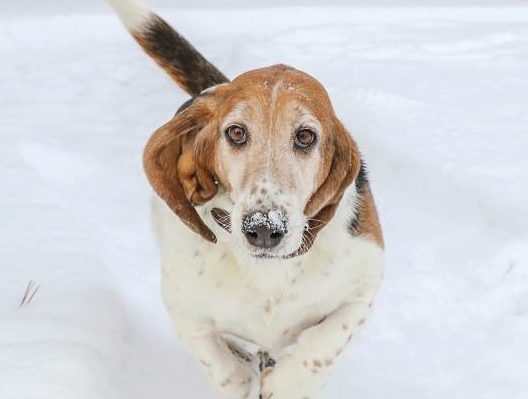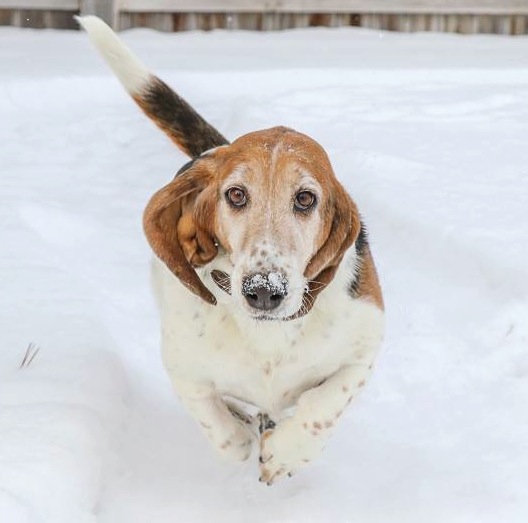
You’re ready now to begin your first experience with “shaping” your dog’s behavior using a clicker and treats. Your goal is simple: your dog on the spot you’ve chosen for him to stay while you open an outside door.
Begin the process simply, in a quiet, undistracting location. Your dog is accustomed to the sound of the clicker and the reward that follows that sound immediately—a treat that is of high value to the dog. Your dog is empty, hungry, and wide awake; you are calm, patient, and open-minded.
Put down on the floor nearby the rug or mat you use for the dog’s “spot.” If you use a particular location in your home—like where the carpeting meets the tile in your foyer, or an open kennel in your front hall—locate yourself and the dog near that spot.
▪ Make sure the kennel door is wide open (or remove it entirely for now).
▪ Make sure the rug or mat is well-secured so it won’t slip and slide around.
▪ Make sure your “artificial barriers” are set up, if you intend to use them.
Keep the treats on your person for easy access. (You will access them often!) You may use a commercially made “treat pouch” with a “French purse” closing (snaps open and closed easily), or you may use a plastic baggie in your pocket. That’s your choice.
Practice accessing and delivering the treats as you “charge the clicker” with a warm-up of click-treat, click-treat—throwing the treats near but not at your dog. (The dog should not be expected to catch the treats in the air.)
Plan to work with the dog for only a short period of time. Quit while you’re ahead, while the dog wants more. Ideally, end the session on a high note, with a success. Set a timer on your watch, if you can, or keep an eye on a wall clock if there’s one in sight. Do not set a kitchen timer or any similar device—they are just too darn loud! The timer is meant to tell you when to stop, not to alarm the dog. Ask a family member, if someone’s available, to quietly let you know when five minutes is up.
Repeat these short sessions many times throughout a day.
▪ Stand calmly with clicker in hand. Observe the dog closely—very closely.
▪ Look for any movement of the dog in the direction of the “spot.” It could be a turn toward the spot with the dog’s full body, but it could also be the veer of a muzzle in that direction, and no more.
▪ Your job is to click at the instant that movement is happening. Mark that moment with the click, then immediately throw the treat.
▪ The dog pursues and eats the treat. (The treats are tiny, so “swallow” might be the best description.)
▪ Repeat. Observe the dog closely, click for any movement in the direction of the “spot.” Click, treat, repeat.
You will soon find yourself making value judgements as you go along. Was that a movement? Is an eye flick a movement? Did he pick up that foot? Did he move that foot in the direction of the spot, even just a millimeter? He sat . . . but did sitting get him nearer to the spot? And on and on . . .
You are experiencing yourself learning how to use a clicker!

Photo by Cherie Marshall
Were your expectations too high? Is the clicker not at all magical? It’s been five minutes and your dog is no closer to the “spot” than he was when you started! Are you angry? Discouraged? Knock that off, human! This is not magic, nor is it ever going to be quick.
You feel awkward and uncertain because this is your first time attempting a skill that takes a long time to master. This is like learning to drive a car. Sure, you can point the thing and step on the gas, but you are not ready to leave the driveway yet, and cruising the freeway is far in the future. Accept your awkwardness. You’re normal!
This is a game of hot and cold . . . except without the cold. You click when your dog is “hot” (on the right track). You do nothing when your dog is “cold” (on the wrong track). That alone is a new way of thinking for many of us humans, who persist in assuming that “wrong” is just as important to convey as “right.” In this case, you deal only with “right”—to your dog’s benefit, and your own.
What will your dog do? Every dog is different, just like every human, so any preconceived notions you have will probably fly out the window. Your very active and enthusiastic dog may fling himself around the room like a toddler . . . or he may stand quietly trying to figure out what the heck is going on. Your shy and subdued dog may move very little . . . or she may start jumping around like an uninhibited pup.
There’s no way to know until you try. And every time you do, something different, something new will happen. You will see little or no improvement over several sessions and then, as if a lightbulb has popped on, you will see your dog leap ahead in comprehension. You will see steady improvement and then, for no reason you can perceive, you will see your dog act as if this is all unfamiliar territory and a little intimidating. You will experience excitement and discouragement. You will want to give up, then, minutes later, you will never want to stop because it’s going so well.
Expect all of that.
What will you get? As you continue to practice for short periods of time over many days, you should get a dog that you’ve “shaped” by tiny increments to move from wherever he starts in the room toward the “spot” you’ve chosen. First the head turns, then a foot follows, then the body comes along. Step by step, foot by foot, the dog is click-treated for every movement that gets him closer to the spot. When he actually arrives at the spot, you click-treat with a jackpot!
What’s a jackpot? It’s the pot of gold at the end of the rainbow! It’s not just one treat but a whole handful of them, thrown up in the air. It’s a celebration—and, in this case, it should probably be the end of the training session as well. Let your dog snuffle around and find all those jackpot treats, then take him outside for a fun game of fetch or a run with you around the block. He’s a success!
Then go watch some more videos on clicker training. Not the advanced ones where a trainer teaches the dog how to perform some skill worthy of a doggy circus act. Stick to simple, beginning tasks, like teaching body positions (sit, down) or paw tricks (shake, high five). Watch a variety of trainers train a variety of dogs—not just the really smart, really good dogs, but normal beginner dogs like yours. See how even experienced trainers sometimes fail to click with perfect timing? Notice how that can throw the whole training session off as the dog offers a behavior that’s not the one wanted?
It happens to the best of trainers, it happens with the best of dogs. We are human and they are canine, and none of us is perfect! Observe and learn. Vow not to make that mistake again, but accept that you will make many others. Don’t beat yourself up for an unproductive session. Instead, later, review what you did that worked and what you did that didn’t work. Revise and adapt. Persevere.
Next week—putting it all together. You’ve “shaped” your dog to go to the spot you’ve chosen for him to stay while you open your front door. Now it’s time to put that behavior “on cue” and have the dog follow going to the spot with staying on the spot until released. Practice the dog’s down-stays this week, too. Prepare for the next stage in training the behavior that will make door-dashing a thing of the past!



